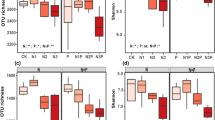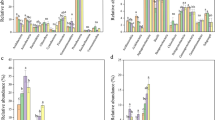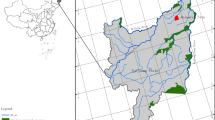Abstract
Soil microorganisms play key roles in terrestrial biogeochemical cycles and ecosystem functions. However, few studies address how long-term nitrogen (N) addition gradients impact soil bacterial and fungal diversity and community composition simultaneously. Here, we investigated soil bacterial and fungal diversity and community composition based on a long-term (17 years) N addition gradient experiment (six levels: 0, 2, 4, 8, 16, 32 gN m−2 year−1) in temperate grassland, using the high-throughput Illumina MiSeq sequencing. Results showed that both soil bacterial and fungal alpha diversity responded nonlinearly to the N input gradient and reduced drastically when the N addition rate reached 32 g N m−2 year−1. The relative abundance of soil bacterial phyla Proteobacteria increased and Acidobacteria decreased significantly with increasing N level. In addition, the relative abundance of bacterial functional groups associated with aerobic ammonia oxidation, aerobic nitrite oxidation, nitrification, respiration of sulfate and sulfur compounds, and chitinolysis significantly decreased under the highest N addition treatment. For soil fungi, the relative abundance of Ascomycota increased linearly along the N enrichment gradient. These results suggest that changes in soil microbial community composition under elevated N do not always support the copiotrophic-oligotrophic hypothesis, and some certain functional bacteria would not simply be controlled by soil nutrients. Further analysis illustrated that reduced soil pH under N addition was the main factor driving variations in soil microbial diversity and community structure in this grassland. Our findings highlight the consistently nonlinear responses of soil bacterial and fungal diversity to increasing N input and the significant effects of soil acidification on soil microbial communities, which can be helpful for the prediction of underground ecosystem processes in light of future rising N deposition.







Similar content being viewed by others
Data Availability
All obtained sequences have been deposited in the SRA of NCBI database under the bioproject numbers PRJNA777017.
References
Erisman JW, Galloway JN, Seitzinger S, Bleeker A, Dise NB, Petrescu AMR, Leach AM, de Vries W (2013) Consequences of human modification of the global nitrogen cycle. Phil Trans R Soc B Biol Sci 368:20130116
Phoenix GK, Emmett BA, Britton AJ, Caporn SJM, Dise NB, Helliwell R, Jones L, Leake JR, Leith ID, Sheppard LJ, Sowerby A, Pilkington MG, Rowe EC, Ashmorek MR, Power SA (2012) Impacts of atmospheric nitrogen deposition: responses of multiple plant and soil parameters across contrasting ecosystems in long-term field experiments. Glob Change Biol 18(4):1197–1215
Schimel JP, Schaeffer SM (2012) Microbial control over carbon cycling in soil. Front Microbiol 3:348
van der Heijden MGA, Bardgett RD, van Straalen NM (2008) The unseen majority: soil microbes as drivers of plant diversity and productivity in terrestrial ecosystems. Ecol Lett 11(3):296–310
Treseder KK (2008) Nitrogen additions and microbial biomass: a meta-analysis of ecosystem studies. Ecol Lett 11(10):1111–1120
Wang C, Liu D, Bai E (2018) Decreasing soil microbial diversity is associated with decreasing microbial biomass under nitrogen addition. Soil Biol Biochem 120:126–133
Zhang TA, Chen HYH, Ruan H (2018) Global negative effects of nitrogen deposition on soil microbes. ISME J 12(7):1817–1825
Zhou Z, Wang C, Zheng M, Jiang L, Luo Y (2017) Patterns and mechanisms of responses by soil microbial communities to nitrogen addition. Soil Biol Biochem 115:433–441
Lu G, **e B, Cagle GA, Wang X, Han G, Wang X, Hou A, Guan B (2021) Effects of simulated nitrogen deposition on soil microbial community diversity in coastal wetland of the Yellow River Delta. Sci Total Environ 757:143825
Freedman ZB, Romanowicz KJ, Upchurch RA, Zak DR (2015) Differential responses of total and active soil microbial communities to long-term experimental N deposition. Soil Biol Biochem 90:275–282
Zhang Y, Dong SK, Gao QZ, Liu SL, Ganjurjav H, Wang XX, Su XK, Wu XY (2017) Soil bacterial and fungal diversity differently correlated with soil biochemistry in alpine grassland ecosystems in response to environmental changes. Sci Rep 7:1–10
Ai C, Zhang SQ, Zhang X, Guo DD, Zhou W, Huang SM (2018) Distinct responses of soil bacterial and fungal communities to changes in fertilization regime and crop rotation. Geoderma 319:156–166
Strickland MS, Rousk J (2010) Considering fungal:bacterial dominance in soils - methods, controls, and ecosystem implications. Soil Biol Biochem 42(9):1385–1395
Wang JQ, Shi XZ, Zheng CY, Suter H, Huang ZQ (2021) Different responses of soil bacterial and fungal communities to nitrogen deposition in a subtropical forest. Sci Total Environ 755:142449
Widdig M, Heintz-Buschart A, Schleuss PM, Guhr A, Borer ET, Seabloom EW, Spohn M (2020) Effects of nitrogen and phosphorus addition on microbial community composition and element cycling in a grassland soil. Soil Biol Biochem 151:108041
Dai ZM, Su WQ, Chen HH, Barberan A, Zhao HC, Yu MJ, Yu L, Brookes PC, Schadt CW, Chang SX, Xu JM (2018) Long-term nitrogen fertilization decreases bacterial diversity and favors the growth of Actinobacteria and Proteobacteria in agro-ecosystems across the globe. Glob Change Biol 24(8):3452–3461
Liu WX, Jiang L, Yang S, Wang Z, Tian R, Peng ZY, Chen YL, Zhang XX, Kuang JL, Ling N, Wang SP, Liu LL (2020) Critical transition of soil bacterial diversity and composition triggered by nitrogen enrichment. Ecology 101(8):e03053
Dong CC, Shi Y, Wang JJ, Zeng H, Wang W (2021) Divergent responses of the soil bacteria community to multi-level nitrogen enrichment in temperate grasslands under different degrees of degradation. Land Degrad Dev 32(13):3524–3535
Fierer N, Lauber CL, Ramirez KS, Zaneveld J, Bradford MA, Knight R (2012) Comparative metagenomic, phylogenetic and physiological analyses of soil microbial communities across nitrogen gradients. ISME J 6(5):1007–1017
Berthrong ST, Yeager CM, Gallegos-Graves L, Steven B, Eichorst SA, Jackson RB, Kuske CR (2014) Nitrogen fertilization has a stronger effect on soil nitrogen-fixing bacterial communities than elevated atmospheric CO2. Appl Environ Microbiol 80(10):3103–3112
Grosso F, Bååth E, De Nicola F (2016) Bacterial and fungal growth on different plant litter in Mediterranean soils: effects of C/N ratio and soil pH. Appl Soil Ecol 108:1–7
Waring BG, Averill C, Hawkes CV (2013) Differences in fungal and bacterial physiology alter soil carbon and nitrogen cycling: insights from meta-analysis and theoretical models. Ecol Lett 16(7):887–894
Bru D, Ramette A, Saby NPA, Dequiedt S, Ranjard L, Jolivet C, Arrouays D, Philippot L (2011) Determinants of the distribution of nitrogen-cycling microbial communities at the landscape scale. ISME J 5(3):532–542
Fierer N (2017) Embracing the unknown: disentangling the complexities of the soil microbiome. Nat Rev Microbiol 15(10):579–590
Zhalnina K, Dias R, de Quadros PD, Davis-Richardson A, Camargo FAO, Clark IM, McGrath SP, Hirsch PR, Triplett EW (2015) Soil pH determines microbial diversity and composition in the Park Grass Experiment. Microb Ecol 69(2):395–406
Zhou ZH, Wang CK, Luo YQ (2020) Meta-analysis of the impacts of global change factors on soil microbial diversity and functionality. Nat Commun 11:3072
Ling N, Chen DM, Guo H, Wei JX, Bai YF, Shen QR, Hu SJ (2017) Differential responses of soil bacterial communities to long-term N and P inputs in a semi-arid steppe. Geoderma 292:25–33
Zeng J, Liu XJ, Song L, Lin XG, Zhang HY, Shen CC, Chu HY (2016) Nitrogen fertilization directly affects soil bacterial diversity and indirectly affects bacterial community composition. Soil Biol Biochem 92:41–49
Zhang YT, Shen H, He XH, Thomas B, Lupwayi NZ, Hao XY, Thomas MC, Shi XJ (2017) Fertilization shapes bacterial community structure by alteration of soil pH. Front Microbiol 8:1325
Klindworth A, Pruesse E, Schweer T, Peplies J, Quast C, Horn M, Glockner FO (2013) Evaluation of general 16S ribosomal RNA gene PCR primers for classical and next-generation sequencing-based diversity studies. Nucleic Acids Research 41(1)
**ong W, Li R, Ren Y, Liu C, Zhao QY, Wu HS, Jousset A, Shen QR (2017) Distinct roles for soil fungal and bacterial communities associated with the suppression of vanilla Fusarium wilt disease. Soil Biol Biochem 107:198–207
Chen SF, Zhou YQ, Chen YR, Gu J (2018) Fastp: an ultra-fast all-in-one FASTQ preprocessor. Bioinformatics 34(17):884–890
Magoc T, Salzberg SL (2011) FLASH: fast length adjustment of short reads to improve genome assemblies. Bioinformatics 27(21):2957–2963
Edgar RC (2013) UPARSE: highly accurate OTU sequences from microbial amplicon reads. Nat Methods 10(10):996–998
Louca S, Parfrey LW, Doebeli M (2016) Decoupling function and taxonomy in the global ocean microbiome. Science 353(6305):1272–1277
Nguyen NH, Song ZW, Bates ST, Branco S, Tedersoo L, Menke J, Schilling JS, Kennedy PG (2016) FUNGuild: an open annotation tool for parsing fungal community datasets by ecological guild. Fungal Ecol 20:241–248
Huang JY, Xu YX, Yu HL, Zhu WW, Wang P, Wang B, Na XF (2021) Soil prokaryotic community shows no response to 2 years of simulated nitrogen deposition in an arid ecosystem in northwestern China. Environ Microbiol 23(2):1222–1237
McHugh TA, Morrissey EM, Mueller RC, Gallegos-Graves LV, Kuske CR, Reed SC (2017) Bacterial, fungal, and plant communities exhibit no biomass or compositional response to two years of simulated nitrogen deposition in a semiarid grassland. Environ Microbiol 19(4):1600–1611
Wei HW, Wang XG, Li YB, Yang JJ, Wang JF, Lu XT, Han XG (2020) Simulated nitrogen deposition decreases soil microbial diversity in a semiarid grassland, with little mediation of this effect by mowing. Pedobiologia 80:150644
Chen DM, **ng W, Lan ZC, Saleem M, Wu Y, Hu SJ, Bai YF (2019) Direct and indirect effects of nitrogen enrichment on soil organisms and carbon and nitrogen mineralization in a semi-arid grassland. Funct Ecol 33(1):175–187
Nie YX, Wang MC, Zhang W, Ni Z, Hashidoko Y, Shen WJ (2018) Ammonium nitrogen content is a dominant predictor of bacterial community composition in an acidic forest soil with exogenous nitrogen enrichment. Sci Total Environ 624:407–415
Weber CF, Vilgalys R, Kuske CR (2013) Changes in fungal community composition in response to elevated atmospheric CO2 and nitrogen fertilization varies with soil horizon. Front Microbiol 4:78
Chen DM, Lan ZC, Hu SJ, Bai YF (2015) Effects of nitrogen enrichment on belowground communities in grassland: Relative role of soil nitrogen availability vs. soil acidification. Soil Biol Biochem 89:99–108
Rousk J, Baath E, Brookes PC, Lauber CL, Lozupone C, Caporaso JG, Knight R, Fierer N (2010) Soil bacterial and fungal communities across a pH gradient in an arable soil. ISME J 4(10):1340–1351
Wan WJ, Tan JD, Wang Y, Qin Y, He HM, Wu HQ, Zuo WL, He DL (2020) Responses of the rhizosphere bacterial community in acidic crop soil to pH: changes in diversity, composition, interaction, and function. Sci Total Environ 700:134418
Jones RT, Robeson MS, Lauber CL, Hamady M, Knight R, Fierer N (2009) A comprehensive survey of soil acidobacterial diversity using pyrosequencing and clone library analyses. ISME J 3(4):442–453
Lauber CL, Hamady M, Knight R, Fierer N (2009) Pyrosequencing-based assessment of soil pH as a predictor of soil bacterial community structure at the continental scale. Appl Environ Microbiol 75(15):5111–5120
Fierer N, Bradford MA, Jackson RB (2007) Toward an ecological classification of soil bacteria. Ecology 88(6):1354–1364
Zhang XM, Wei HW, Chen QS, Han XG (2014) The counteractive effects of nitrogen addition and watering on soil bacterial communities in a steppe ecosystem. Soil Biol Biochem 72:26–34
Chen YL, Xu ZW, Feng K, Yang GW, Fu W, Chen BD (2020) Nitrogen and water addition regulate soil fungal diversity and co-occurrence networks. J Soils Sediments 20(8):3192–3203
Huang G, Li L, Su YG, Li Y (2018) Differential seasonal effects of water addition and nitrogen fertilization on microbial biomass and diversity in a temperate desert. CATENA 161:27–36
Blackwood CB, Waldrop MP, Zak DR, Sinsabaugh RL (2007) Molecular analysis of fungal communities and laccase genes in decomposing litter reveals differences among forest types but no impact of nitrogen deposition. Environ Microbiol 9(5):1306–1316
**ng W, Lu XM, Ying JY, Lan ZC, Chen DM, Bai YF (2022) Disentangling the effects of nitrogen availability and soil acidification on microbial taxa and soil carbon dynamics in natural grasslands. Soil Biol Biochem 164:108495
Acknowledgements
The authors thank the staff of Duolun Restoration Ecology Experimentation and Demonstration Station for their assistance in field sampling.
Funding
This study was financially supported by the National Natural Science Foundation of China (31800403, 41977009, 41977039) and the Natural Science Foundation of Shandong Province (ZR2020QD115).
Author information
Authors and Affiliations
Contributions
All authors contributed to the study conception and design. Material preparation, data collection, and analysis were performed by Bing Song, Liuyi Yang, and Huiqiu Shi. The experiment was conceived and designed by Linghao Li and Wenming Bai. Data analysis was performed by Bing Song and Yong Li. The first draft of the manuscript was written by Bing Song and all authors commented on previous versions of the manuscript. All authors read and approved the final manuscript.
Corresponding author
Ethics declarations
Competing Interests
The authors declare no competing interests.
Supplementary Information
Below is the link to the electronic supplementary material.
Rights and permissions
About this article
Cite this article
Song, B., Li, Y., Yang, L. et al. Soil Acidification Under Long-Term N Addition Decreases the Diversity of Soil Bacteria and Fungi and Changes Their Community Composition in a Semiarid Grassland. Microb Ecol 85, 221–231 (2023). https://doi.org/10.1007/s00248-021-01954-x
Received:
Accepted:
Published:
Issue Date:
DOI: https://doi.org/10.1007/s00248-021-01954-x




